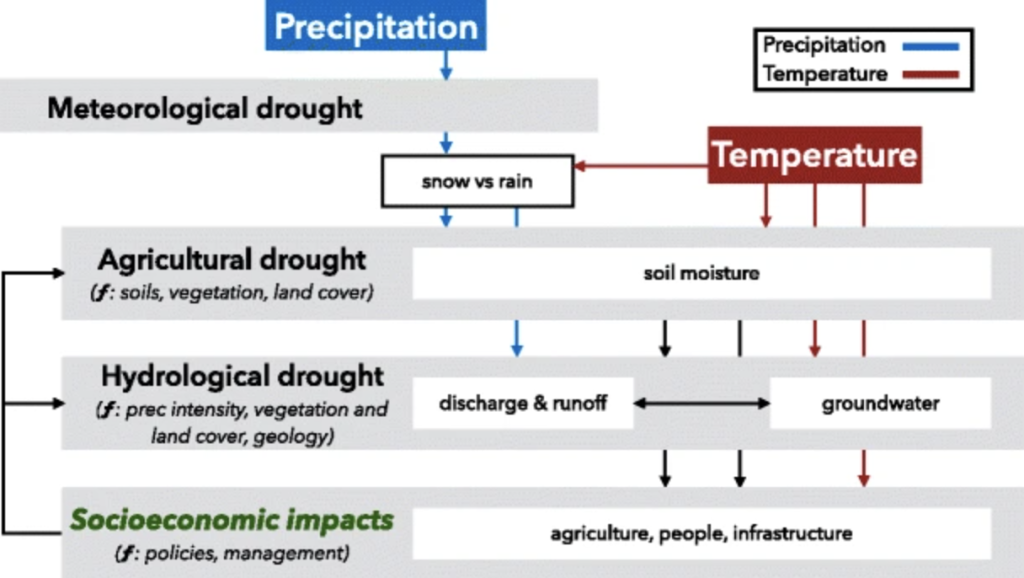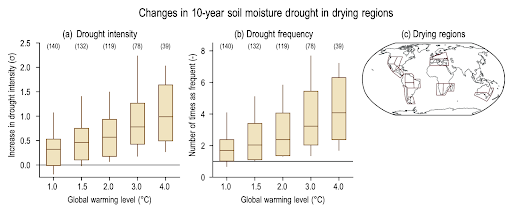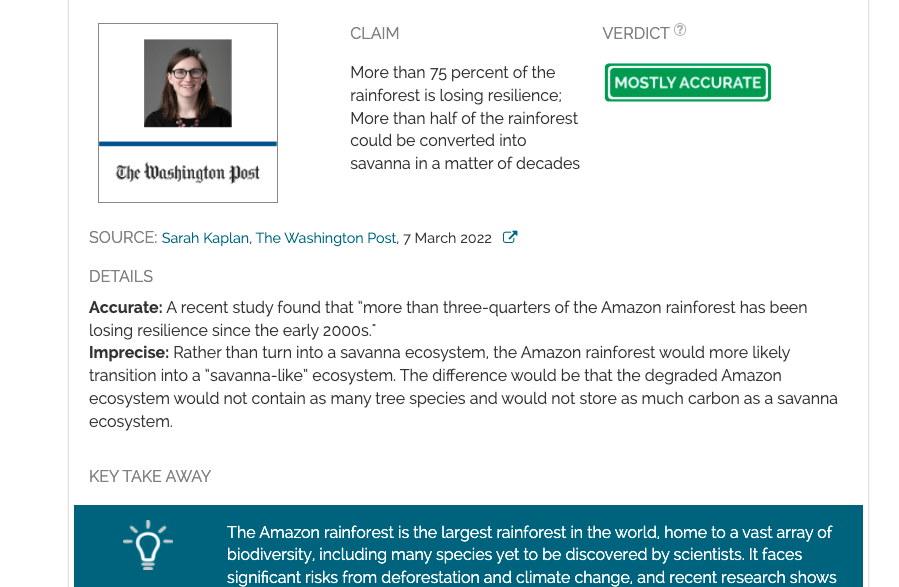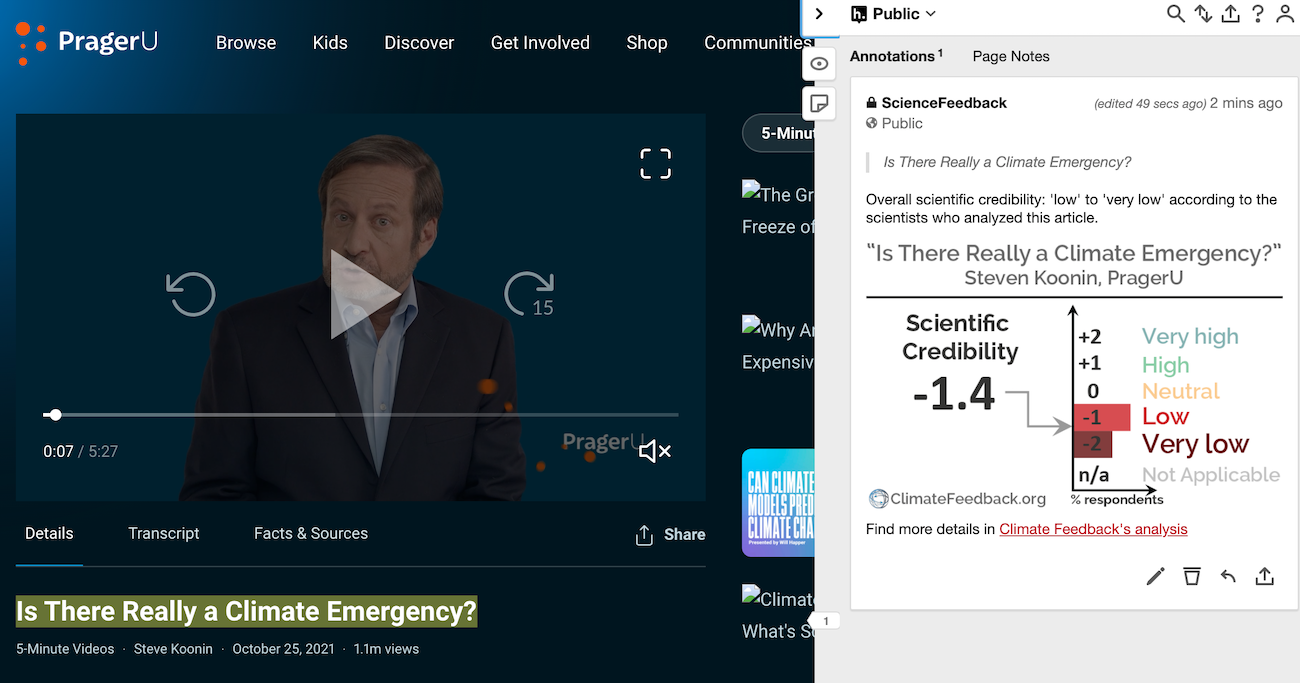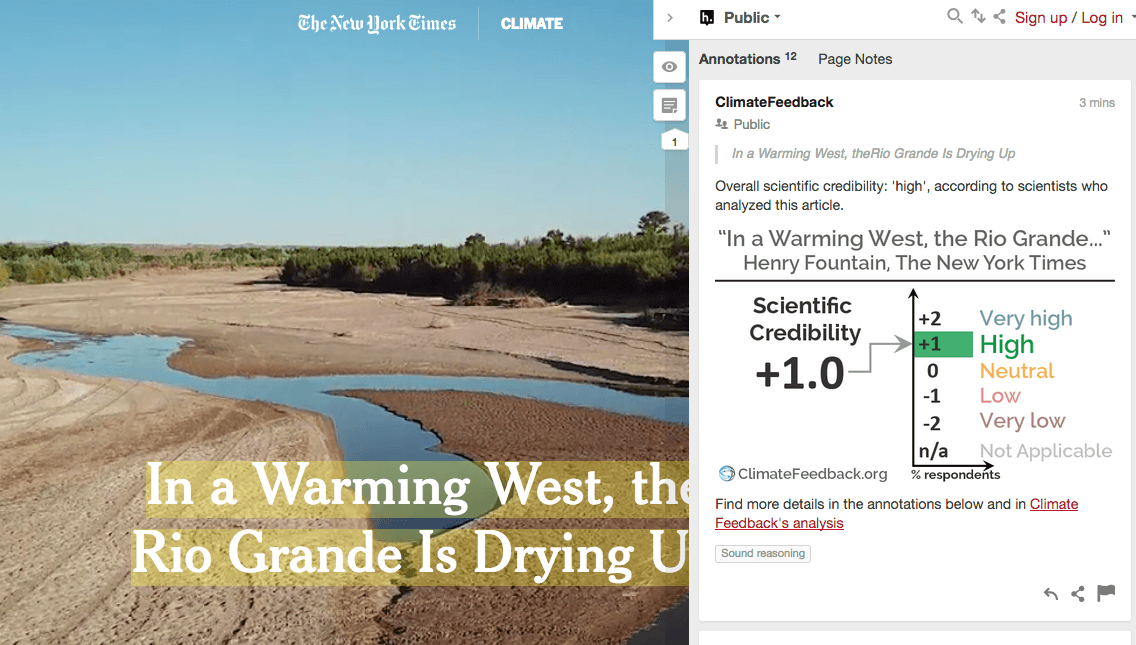- Climate
Water scarcity in a changing climate: will drought get worse with warming?
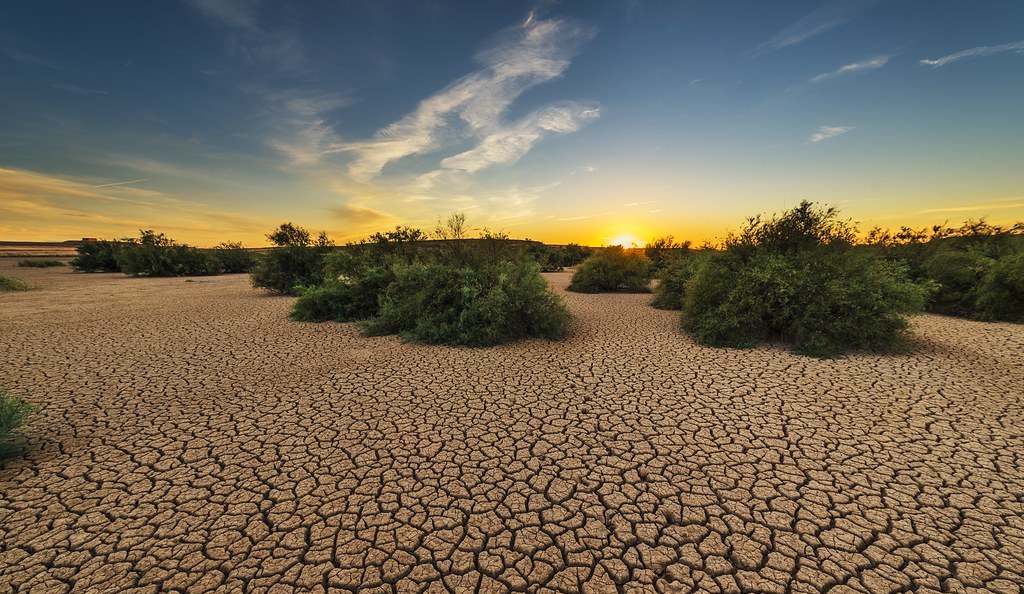
A recent U.N. report notes that drought was responsible for approximately 650,000 deaths between 1970 and 2019, with 90% occurring in developing countries. Economic losses associated with drought have also been counted in the hundreds of billions USD over the last decade. The report states that human-caused climate change is expected to worsen drought conditions and exacerbate these problems. An article published in the conservative think tank Heartland Institute’s Climate Realism website, however, has argued that the relationship between climate change and drought is limited and that the Intergovernmental Panel on Climate Change (IPCC) previously found that climate change will increase rainfall.
To better understand the relationship between climate change and drought, Climate Feedback reached out to scientific experts in the field. In this article, we examine the ways in which global warming is likely to impact water scarcity around the world. We highlight that the available scientific evidence, including that of the IPCC, indicates that drought frequency, duration and intensity is expected to increase in agriculturally important regions under global warming.
Drought is defined as a “sustained period of below-normal water availability.”[1] Scientists who study drought typically distinguish between different types of the phenomenon, based on where in the water cycle the shortage occurs (Fig. 1). Meteorological drought, for example, refers to a shortage of water driven by a reduction in rain and is historically responsible for driving all other drought types, such as agricultural and ecological drought (i.e., a water shortage in soil) and hydrological drought (i.e., a water shortage in other surface –e.g., rivers– and subsurface –e.g., aquifers– areas of Earth), as well as their socioeconomic impacts (Fig. 1).[2]
Figure 1. Schematic representation of different drought types and their historical drivers and impacts. Source: Cook et al., 2018
Because drought can have major impacts on essential water and food supplies, considerable scientific effort has been devoted to understanding the potential influence of human-caused climate change on drought. Specifically, climate change may alter the behavior of rain, evaporation and temperature, which could all have consequences for future water availability. However, drought may also be impacted by non-climatic factors, such as land-use changes.[3]
Linnea Lueken, a former petroleum engineer and geologist now a research fellow at the Heartland Institute, a think tank which has been previously funded by oil and gas interests and has a long history of science denial, recently argued that climate change has not worsened drought. Leuken’s article, published in the Heartland Institute’s Climate Realism website, was a rebuttal to a Time Magazine article authored by Wanjohi Kabukuru reporting on a recent U.N. Drought in Numbers report, which found a link between climate change and increased frequency and duration of drought.
Leuken claims that “drought-tracking data show no meaningful trend in severity or frequency of drought globally.” However, Benjamin Cook, a climate scientist who studies drought at Lamont Doherty Earth Observatory, Columbia University, says that Leuken’s claim is misleading. “Droughts are extreme, discrete events that represent a deviation from a normal baseline,” notes Cook. “Historically, their primary cause is natural variability in precipitation, for which the trends in most regions are insignificant. However, these natural variations are now occurring in a world with climate change. Which means that when they do occur, climate change has the potential to increase their severity or duration.”[4]
According to Leuken, the Time Magazine article and Drought in Numbers report contradict findings from the U.N.’s Intergovernmental Panel on Climate Change Sixth Assessment Report (IPCC AR6).[5] “The U.N. remarks that there is actually ‘high confidence’ in a trend of increasing precipitation over at least the mid-latitudes of the Earth,” writes Leuken. However, this is another misleading statement, as rainfall is not the only factor that impacts drought. As Cook says, “Drought is also soil moisture and streamflow. This is an important distinction, because it means that other processes that may be affected by climate change (e.g., evaporation) can play a role in increasing drought, even if precipitation does not change” (Fig. 2).
Figure 2. Climatic drivers of water availability and drought. Note that precipitation is only one factor that influences drought, and so it is not correct to assume that an increase in global precipitation will necessarily reduce drought. Source: Ch. 8, Working Group I, IPCC AR6
“Many of the increases in drought in climate change projections are driven by direct temperature effects on evaporation and snow, and not changes in precipitation. Indeed, precipitation does, overall, increase globally, but one can see that this does not translate directly to increases in soil moisture or runoff in many regions” (Fig. 3), continues Cook, citing a 2020 publication on the matter.[6] Indeed, scientists recently linked warming-driven evaporation to increased drought throughout the western U.S., which may have implications for both water supply and wildfire risks in the region.[7]
Cook touches on another important point about drought: it is, by definition, a regional phenomenon. However, it is noteworthy that the regions sensitive to climate-induced drought are those that are also agriculturally important. As Lennart Olsson, a drought scientist at Lund University puts it, “the regions with observed droughts are primarily where agriculture is extremely important like western North America, the Mediterranean region, Central Asia and Southern Australia.”
Figure 3. Modeled changes in annual agricultural drought (i.e., soil moisture at the surface, left, and within the total column, right) under different climate scenarios (shared socioeconomic pathways, with lower numbers indicative of relatively more modest climate change) using Climate Model Intercomparison Project 6 (CMIP6) models. Areas colored in brown indicate higher agricultural drought conditions expected from climate change whereas areas colored in blue/green indicate those that are expected to respond with less drought. Note that there is high regional variability, demonstrating that it is more accurate to discuss climate-driven changes in drought conditions at the regional scale, rather than at the global scale. Source: Cook et al., 2020
While Leuken writes that the IPCC has found that warming only resulted in increased drought in 12 of 47 investigated regions with typically “low” or sometimes “medium” confidence, Olsson notes that confidence in this regard is affected by regional data availability.
“Most sub-regions of the African continent have ‘at least medium confidence’ for increased agricultural and/or ecological drought. Paucity of data is a major reason why confidence is not higher. There are 10 sub-regions in Africa, of which 5 have at least medium confidence about the increase of observed drought, 2 have too little data, and 3 have ‘low agreement in the type of change’. We also have evidence for increased droughts in the entire Mediterranean region and central Asia, as well as north-eastern South America (i.e., part of the Amazon basin),” says Olsson.
Despite Leuken’s accusations against Time’s Kabukuru and the Drought in Numbers report of ignoring “real-world data,” such as those data reported within IPCC AR6, it appears that Leuken is actually the one who has either ignored or misunderstood the content of IPCC AR6. As IPCC AR6 authors clearly state with high confidence, “more regions are affected by increases in agricultural and ecological droughts with increasing global warming”.[5]
Through Leuken’s erroneous assumptions, such as the assumption of a direct link between global precipitation trends and regional drought conditions, and misleading claims, such as the misrepresentation of IPCC AR6 findings, the author arrives at the inaccurate conclusion that climate change will not worsen drought conditions in agriculturally important regions. By contrast, Kabukuru’s article in Time Magazine is mostly accurate. The author correctly reports a main conclusion of the Drought in Numbers report: that climate change will increase the frequency and duration of droughts. However, there is also strong evidence that indicates the intensity of drought will increase under climate change (Fig. 4).
Figure 4. Frequency and intensity of agricultural and ecological droughts under different levels of human-caused warming. Note that the intensity of droughts is expected to increase under increased warming in addition to the frequency and duration of droughts. Source: Working Group I, IPCC AR6 Summary for Policymakers
Reviewers’ Feedback

Associate Research Scientist, Columbia University
The thing to remember is that drought is a very complex phenomenon. For one, drought is not just precipitation. Drought is also soil moisture and streamflow. This is an important distinction, because it means that other processes that may be affected by climate change (e.g., evaporation) can play a role in increasing drought, even if precipitation does not change. This is illustrated really nicely by Figure 8.6 in the water cycle chapter from the AR6 [Figure 2 above].
As a result, many of the increases in drought in climate change projections are driven by direct temperature effects on evaporation and snow, and NOT changes in precipitation. Indeed, precipitation does, overall, increase globally, but one can see that this does not translate directly to increases in soil moisture or runoff in many regions. We discuss this in a paper we published a couple years ago, before the IPCC came out.
Second, drought is a very REGIONAL phenomenon. Droughts are more frequent in some regions than others, their impacts can be larger or smaller depending on the region, and we expect the impacts of drought to be worse in some areas than others. These complexities mean that broad, global statements about climate change and drought, as in the Climate Realism piece, can be misleading. Some more specifics:
[Regarding these statements:]
“Climate change will increase the frequency and duration of droughts”
“Climate change has already increased the frequency and duration of droughts”
I would add “severity” into the mix here (and indeed, I think the evidence for severity changes is stronger than frequency or duration), which would make these statements well supported by the latest IPCC report. Lots of details in the Water Cycle and Extremes chapters, but you can see this quite clearly as well in graphics (Figure SPM.3, Figure SPM.5B, Figure SPM.6) from the IPCC Summary for Policy Makers.
Figure 11.18 in Chapter 11 also highlights how soil moisture drought intensity and frequency will change under different global warming levels, and includes a map outlining regions where the risks are strongest:
Figure 5. Agricultural and ecological drought intensity (left) and frequency (right) in the regions where climate change is expected to have an impact relative to the 1850-1900 baseline. Note that both drought intensity and frequency increase under global warming. Source: Ch. 11, Working Group I, IPCC AR6
[Climate Realism claim:] “Drought-tracking data show no meaningful trend in severity or frequency of drought”
This is a good example of a misleading statement. Droughts are extreme, discrete events that represent a deviation from a normal baseline. Historically, their primary cause is natural variability in precipitation, for which the trends in most regions are insignificant. HOWEVER, these natural variations are now occurring in a world with climate change. Which means that when they do occur, climate change has the potential to increase their severity or duration. A good example is some recent work we published on the ongoing megadrought in the western US.[8]

Professor, Department of Geography, Lund University
For future expected events we can have a varying degrees of confidence in the projections based on different factors, e.g. the quality of the models (i.e. how well they can represent historical events), the quality of the data (normally models are “trained” on historical data, and good data means good model performance), time period of projections (the further into the future the more uncertain projection is a rule of thumb).
The “available evidence” referred to is probably the figure SPM.3 which shows that most sub-regions of the African continent have “at least medium confidence” for increased agricultural and/or ecological drought. Paucity of data is a major reason why the confidence is not higher. There are 10 sub-regions in Africa of which 5 have at least medium confidence about the increase of observed droughts, 2 have too little data, and 3 have “low agreement in the type of change”. We also have evidence for increased droughts in the entire Mediterranean region and Central Asia, as well as NE South America (i.e. part of the Amazon basin) About future droughts, models in general predict reduced soil moisture (i.e. agricultural and/or ecological drought) in regions like northern Africa and the Mediterranean region, Southern Africa, and most of Northern South America. In some other areas, like central Africa, there are expectations of increasing soil moisture. In dry areas there can also be expectations of increased soil moisture when looking at standard deviations – but this should be interpreted with a lot of caution (which IPCC also writes clearly).
References
- 1 – Van Loon (2015). Hydrological drought explained. WIREs Water.
- 2 – Cook et al. (2018). Climate change and drought: from past to future. Current Climate Change Reports
- 3 – Zipper et al. (2019). Land use change impacts on European heat and drought: remote land-atmosphere feedbacks mitigated locally by shallow groundwater. Environmental Research Letters
- 4 – Marvel et al. (2019). Twentieth-century hydroclimate changes consistent with human influence. Nature.
- 5 – IPCC (2021). Sixth Assessment Report.
- 6 – Cook et al. (2020). Twenty-first century drought projections in the CMIP6 forcing scenarios. Earth’s Future.
- 7 – Albano et al. (2022). A multidataset assessment of climatic drivers and uncertainties of recent trends in evaporative demand across the continental United States. Journal of Hydrometeorology.
- 8 – Park Williams et al. (2022). Rapid intensification of the emerging southwestern North American megadrought in 2020–2021. Nature Climate Change.

